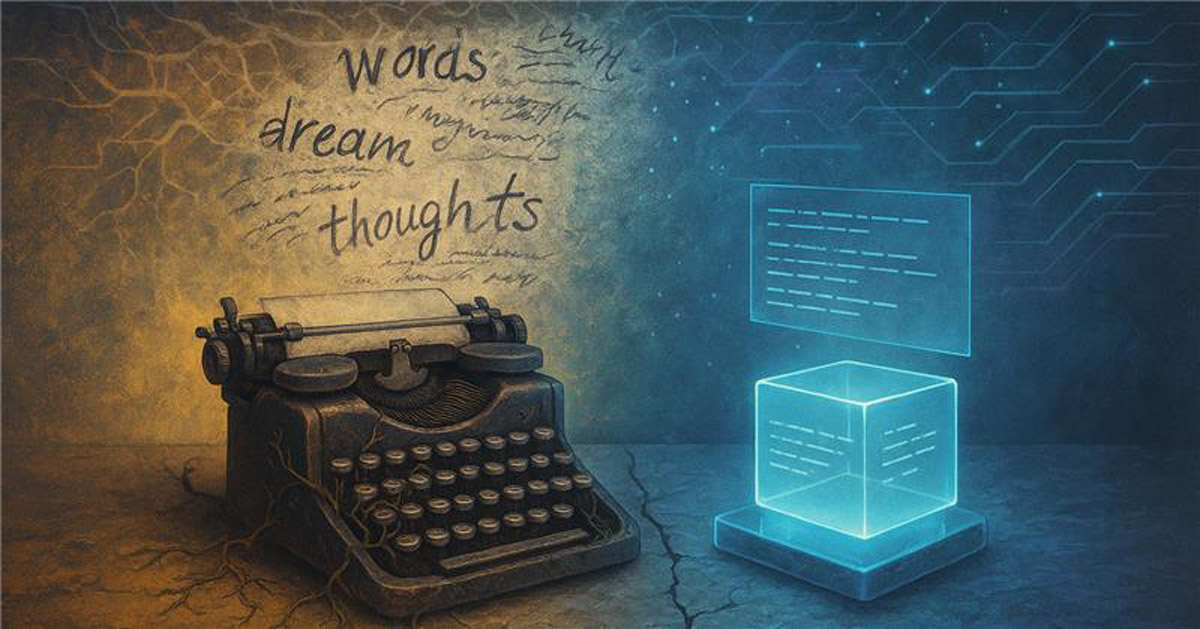The email loomed like a bad car wreck. I didn’t want to look at it, but I couldn’t look away. My reply window stared back, blank and unhelpful, the cursor mocking me with every blink. I wasn’t stalling. I was paralyzed by the stakes. How do you apologize for something you should’ve never let happen? What words could possibly bridge that gap?
Finally, I did what most of us would do, I asked AI to write it for me. The response was immediate and immaculate. It was a perfect balance of contrition, humility, and professionalism. It was better than anything I could have written.
And that was the problem.
I sat there looking at those perfect paragraphs, each word precisely chosen each sentence expertly crafted. It would have worked. It probably would have worked better than my own stumbling attempt at making things right. But something felt hollow at the core of this efficiency.
“It’s just an email,” whispered that familiar voice of optimization. The same voice that suggests auto-generating meeting summaries, that offers perfect presentation scripts, that promises to handle the heavy lifting of human connection. And that voice isn’t wrong; these tools are more efficient. They’re often more effective, too. But in our rush to embrace AI’s capabilities, we’re facing a question that no algorithm can answer: Which human skills are we willing to let atrophy in the name of progress?
I deleted the AI’s response and started fresh. The final version had rough edges. It meandered in places. It definitely wasn’t as polished as the AI version. But it carried something that no language model could replicate, the weight of genuine accountability. It was imperfect, like all human things. And that was the point.
This isn’t a story about resisting AI. That’s a terrible idea. This is about navigating the fastest technological revolution in human history while preserving the core skills that make us human. Because while AI will hand us the boat, when the storm hits, we still need to know how to swim.
The GPS Mind
London’s black cab drivers spend years mastering what they call “The Knowledge” – memorizing every street, every optimal route through the sprawling metropolis. It’s a tradition that seems quaint in our GPS-enabled world. Yet these drivers consistently outperform their app-wielding peers; not because they’re faster, but because they understand something deeper about navigation.
While GPS always optimizes for speed, veteran cabbies know that sometimes the fastest route isn’t the right route. A rushed business executive needs the express lane to Canary Wharf, but tourists light up at the sight of St. Paul’s Cathedral at sunset. And a local might appreciate the side trip through Borough Market, where the morning air fills with the scent of fresh bread and coffee.
Picasso said, “Learn the rules like a pro, so you can break them like an artist.” These cab drivers embody this principle. They’ve mastered every efficient route possible, precisely so they know when to take the scenic one instead.
We’ve become a society rushing to optimize everything, sometimes forgetting that not every journey calls for the express route. Yes, AI can generate perfect prose, handle difficult conversations, and smooth over human moments with algorithmic precision. Sometimes that’s exactly what we need. Full disclosure – I’m using three different AI tools to help craft this article. But other times, the meandering path, the struggle, the imperfect human touch is precisely the point.
Think about learning to write. When we write something ourselves, we’re not just producing words – we’re organizing thoughts, wrestling with ideas, building neural pathways that serve us in countless other situations. The journey shapes us. But that doesn’t mean we should never use AI to help us write. It means we should be thoughtful about when to take the express route and when we need to walk the longer path.
The real expertise isn’t in always knowing the fastest way; it’s in knowing the moment. Sometimes people need to get there fast, and sometimes they need to see something beautiful along the way. The wisdom lies in knowing the difference.
So how do we know when to floor it and when to wander?
In a world where AI offers instant answers, we need more than instinct. We need a clear filter. Something that slows us down just long enough to ask: Should this be done fast, or should it be done human?
Five Fast Filters for Human-AI Balance
Before handing the wheel to AI, run through these five checks:
- Stakes. Is this a routine update or a relationship-defining moment? The higher the stakes, the more your own judgment (and your own voice) need to show up.
- Audience. Do they need raw data, emotional depth, or both? AI might ace the quarterly report, but it has no business writing a condolence letter.
- Growth. Are you outsourcing practice? Sometimes speed is worth it. But if the task sharpens your thinking or builds a skill you’ll need later, take the longer path. The reps matter.
- Authenticity. Will a polished AI reply feel hollow? Language models can mimic tone, but not vulnerability. If the moment calls for truth over polish, speak for yourself – even if it’s messy.
- Time Pressure. Is this really urgent? Or are we just caught in the reflex of always-on, always-now? Sometimes the bravest thing you can do is slow down.
The Human Skills We Can’t Replace
We’re not just automating tasks. We’re edging out the very muscles that make us human.
Empathy, for instance, doesn’t live in sentiment scores. It lives in the pause before a hard truth, in the way someone’s eyes shift when they’re trying not to cry. AI can’t see that. It can’t sit in silence with someone and just be there. But we can. And we have to keep choosing to.
Judgment doesn’t come from a dataset. It comes from living in the grey; those moments when there isn’t a right answer, just competing truths. That space, the tension, the wrestling. That’s where wisdom lives. And no matter how well we train a model, it can’t go there with us.
Storytelling is another one. Sure, AI can spit out a story arc or mimic tone. But it doesn’t feel the story. It doesn’t know what it’s like to be changed by one, or to write something and realize, halfway through, that it was really about you all along. That’s ours.
And creativity? Not the polished kind. The kind that shows up when you’re frustrated, tired, and out of good ideas. The spark that doesn’t make sense on paper but somehow cracks something open. AI’s good at coloring inside the lines. But we’re the ones who draw new ones.
And maybe the most human thing of all, owning our mistakes. AI can catch an error, but it can’t carry regret. It won’t feel the sting of knowing you hurt someone, and it won’t stay up at night wondering how to make it right. Growth, real growth, only happens when we own what went wrong and decide to try again.
If we hand off these moments too often, we stop practicing them. And if we stop practicing, we forget. Not all at once. Just a little more each time we click “generate.”
AI as Sparring Partner
So, what’s the alternative? Not running from AI, but not surrendering to it either. Think of AI as a sparring partner, not a ghostwriter.
Start with your own words. Write the first draft yourself, even if it’s rough. Let AI punch holes in your logic, spot your blind spots, challenge your assumptions. But you throw the first punch.
When you’re stuck, don’t ask AI to write for you. Ask it to outline what you’ve already written. Let it map your thinking back to you. Sometimes seeing your own ideas through machine eyes shows you exactly where you need to go next.
And consider this: One day a week, no AI until revision. Call it Manual Monday if you need a name. Write emails without suggestions. Draft proposals without prompts. Take the scenic route. Not because it’s better, but because you need to keep those muscles strong.
Think of it like swimming. AI can build you the perfect boat. It can plot the ideal course. It can probably even steer. But when the storm hits and systems fail, you better remember how to swim.
That’s why my next apology will start with my own keystrokes. Not because it will be better. It probably won’t be. But because some moments deserve the full weight of human effort, imperfect as it may be.
This isn’t about resisting progress. It’s about staying human in an AI-accelerated world. About knowing when to sprint and when to walk. About keeping our core skills sharp even as we embrace new tools to enhance them.
Because in the end, AI won’t replace human skills. But humans who use AI might replace those who don’t. The trick is making sure we’re enhancing our humanity, not outsourcing it.
The cursor still blinks at me some mornings, especially when the stakes feel high. But I see it differently now. Not as a taunt, but as an invitation. A chance to choose the human path, even when it’s harder.
Because AI isn’t just changing how we work. It’s shaping who we are. Every time we choose automatic, we’re making a decision: what to sharpen, what to let fade. The tools aren’t the problem. The problem is forgetting we still have a choice.
So yes, let AI help you build the boat. Let it plot the course, check the weather, scan the horizon. But keep swimming. Keep feeling the water. Because when the waves come, and they will, you’ll need more than a perfect vessel. You’ll need the muscle memory that comes from experience in the deep end.
That’s why I didn’t hand this piece over to AI to write for me. It helped, sure, offered structure, challenged phrasing, and mapped some clarity. But the thinking, the shaping, the wrestling? That was human.
Sometimes it’s just better to take the long way.
If you’re ready to unlock productivity opportunities for your workplace after getting started with AI, the team at Doyon Technology Group can help. Connect with us today at connect@doyontechgroup.com to get the conversation started.
––––––
About the Author

Greg Starling serves as the Head of Emerging Technology for Doyon Technology Group. He has been a thought leader for the past twenty years, focusing on technology trends, and has contributed to published articles in Forbes, Wired, Inc., Mashable, and Entrepreneur magazines. He holds multiple patents and has been twice named as Innovator of the Year by the Journal Record. Greg also runs one of the largest AI information communities worldwide.
Doyon Technology Group (DTG), a subsidiary of Doyon, Limited, was established in 2023 in Anchorage, Alaska to manage the Doyon portfolio of technology companies: Arctic Information Technology (Arctic IT®), Arctic IT Government Solutions, and designDATA. DTG companies offer a variety of technology services including managed services, cybersecurity, and professional software implementations and support for cloud business applications.

